Parkside Flux-cored Pfds 33 A1 User Manual
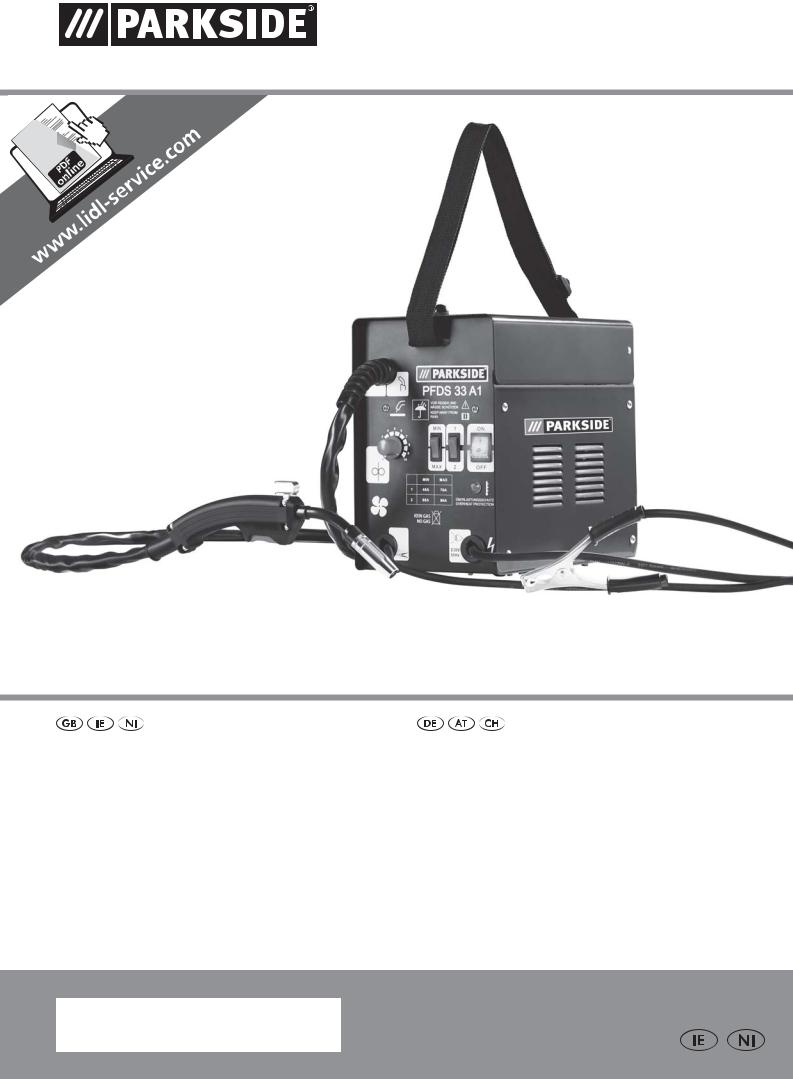
FLUX-CORED WIRE WELDER PFDS 33 A1
FLUX-CORED WIRE WELDER |
FÜLLDRAHT-SCHWEISSGERÄT |
Translation of the original instructions |
Originalbetriebsanleitung |
IAN 280331

Before reading, unfold both pages containing illustrations and familiarise yourself with all functions of the device.
Klappen Sie vor dem Lesen die beiden Seiten mit den Abbildungen aus und machen Sie sich anschließend mit allen Funktionen des Gerätes vertraut.
GB / IE/NI |
Translation of the original instructions |
Page |
1 |
DE / AT / CH |
Originalbetriebsanleitung |
Seite |
17 |
|
|
|
|
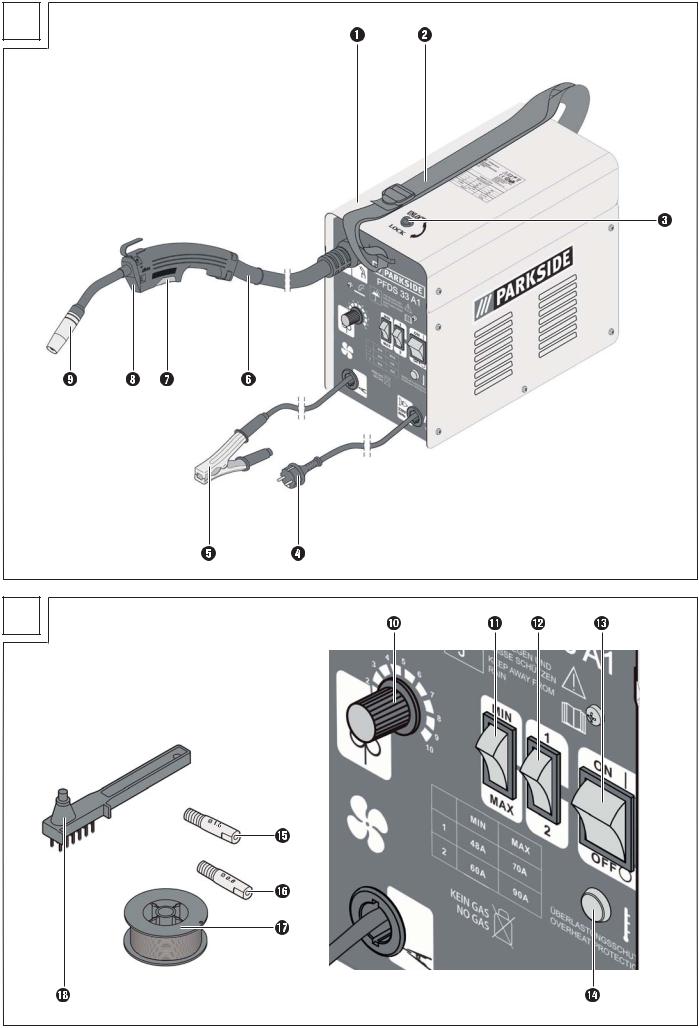
A
B
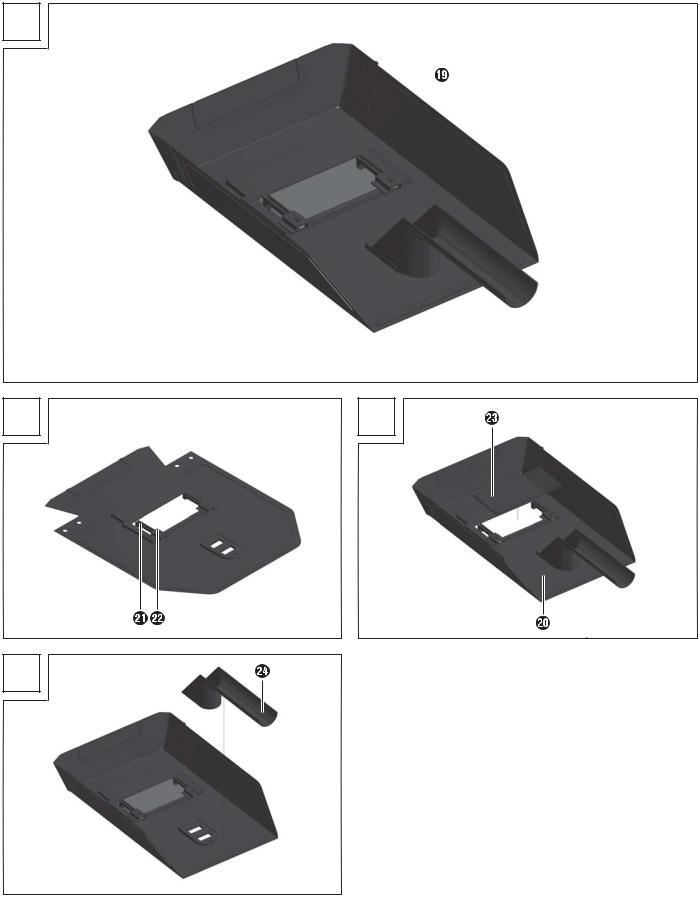
C
D |
E |
F
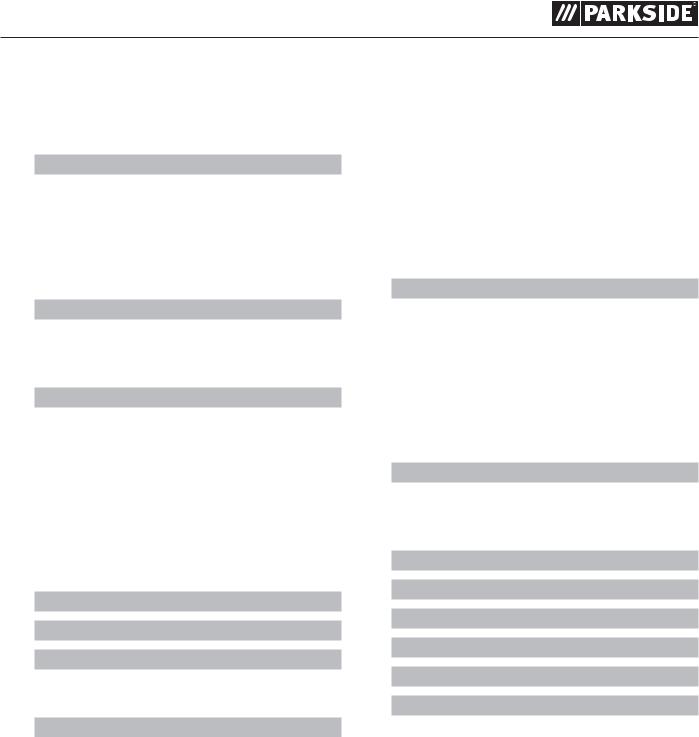
Contents
Introduction . . . . . . . . . . . . . . . . . . . . . . . . . . . . . . . . . 2
Intended use . . . . . . . . . . . . . . . . . . . . . . . . . . . . . . . . . . . . . . . . 2 Residual risk. . . . . . . . . . . . . . . . . . . . . . . . . . . . . . . . . . . . . . . . . 2 Features . . . . . . . . . . . . . . . . . . . . . . . . . . . . . . . . . . . . . . . . . . . . 2 Package contents. . . . . . . . . . . . . . . . . . . . . . . . . . . . . . . . . . . . . 2 Technical details . . . . . . . . . . . . . . . . . . . . . . . . . . . . . . . . . . . . . 3 Rating plate and explanation of symbols . . . . . . . . . . . . . . . . . . 3
Safety . . . . . . . . . . . . . . . . . . . . . . . . . . . . . . . . . . . . . . 4
Basic safety instructions . . . . . . . . . . . . . . . . . . . . . . . . . . . . . . . . 4 Special safety instructions . . . . . . . . . . . . . . . . . . . . . . . . . . . . . . 5 Complementary safety instructions . . . . . . . . . . . . . . . . . . . . . . . 5
Potential hazards . . . . . . . . . . . . . . . . . . . . . . . . . . . . 6
Risk of injury due to electric shock. . . . . . . . . . . . . . . . . . . . . . . . 6 Confined spaces and hot rooms . . . . . . . . . . . . . . . . . . . . . . . . . 6 Accident risks due to poor air supply in confined spaces . . . . . . 6 Protective clothing . . . . . . . . . . . . . . . . . . . . . . . . . . . . . . . . . . . . 6 Protection against radiation and burns . . . . . . . . . . . . . . . . . . . . 7 Risk of burns due to flying sparks . . . . . . . . . . . . . . . . . . . . . . . . 7 Risk of accidents due to spattering slag. . . . . . . . . . . . . . . . . . . . 7 Risk of fire due to flying sparks . . . . . . . . . . . . . . . . . . . . . . . . . . 7 Risk of explosion . . . . . . . . . . . . . . . . . . . . . . . . . . . . . . . . . . . . . 7
EMC appliance classification . . . . . . . . . . . . . . . . . . . . 7
Unpacking and checking the package contents . . . . 8
Assembly . . . . . . . . . . . . . . . . . . . . . . . . . . . . . . . . . . . 8
Fitting the welding mask . . . . . . . . . . . . . . . . . . . . . . . . . . . . . . . 8 Filling with flux-cored wire . . . . . . . . . . . . . . . . . . . . . . . . . . . . . . 8
Operation. . . . . . . . . . . . . . . . . . . . . . . . . . . . . . . . . . 11
Switching the appliance on and o . . . . . . . . . . . . . . . . . . . . . . 11 Setting the welding current . . . . . . . . . . . . . . . . . . . . . . . . . . . . 11 Adjusting the wire feed . . . . . . . . . . . . . . . . . . . . . . . . . . . . . . . 11 Overload protection . . . . . . . . . . . . . . . . . . . . . . . . . . . . . . . . . 11 Welding mask . . . . . . . . . . . . . . . . . . . . . . . . . . . . . . . . . . . . . . 11 Welding. . . . . . . . . . . . . . . . . . . . . . . . . . . . . . . . . . . . . . . . . . . 11
Weld types . . . . . . . . . . . . . . . . . . . . . . . . . . . . . . . . . 12
Forehand welding . . . . . . . . . . . . . . . . . . . . . . . . . . . . . . . . . . . 12 Backhand welding. . . . . . . . . . . . . . . . . . . . . . . . . . . . . . . . . . . 12 Welded joints . . . . . . . . . . . . . . . . . . . . . . . . . . . . . . . . . . . . . . 12 Butt welds . . . . . . . . . . . . . . . . . . . . . . . . . . . . . . . . . . . . . . . . . 12 Flat butt welds . . . . . . . . . . . . . . . . . . . . . . . . . . . . . . . . . . . . . . 12 Welds on an outer edge . . . . . . . . . . . . . . . . . . . . . . . . . . . . . . 12 Welds on an inner edge . . . . . . . . . . . . . . . . . . . . . . . . . . . . . . 13 Overlap welds . . . . . . . . . . . . . . . . . . . . . . . . . . . . . . . . . . . . . . 13
Cleaning and care . . . . . . . . . . . . . . . . . . . . . . . . . . . 13
Wire feed . . . . . . . . . . . . . . . . . . . . . . . . . . . . . . . . . . . . . . . . . 13 Cable assembly. . . . . . . . . . . . . . . . . . . . . . . . . . . . . . . . . . . . . 13 Welder. . . . . . . . . . . . . . . . . . . . . . . . . . . . . . . . . . . . . . . . . . . . 13
Troubleshooting. . . . . . . . . . . . . . . . . . . . . . . . . . . . . 14
Disposal . . . . . . . . . . . . . . . . . . . . . . . . . . . . . . . . . . . 15
Kompernass Handels GmbH warranty . . . . . . . . . . 15
Service . . . . . . . . . . . . . . . . . . . . . . . . . . . . . . . . . . . . 15
Importer . . . . . . . . . . . . . . . . . . . . . . . . . . . . . . . . . . . 15
Translation of the original Conformity Declaration 16
PFDS 33 A1 |
GB│IE│NI │ 1 ■ |

FLUX-CORED WIRE WELDER PFDS 33 A1
Introduction
Congratulations on the purchase of your new appliance. You have selected a high-quality product. The operating instructions are part of this product. They contain important information about safety, usage and disposal.
Before using the product, please familiarise yourself with all operating and safety instructions. Use the product only as described and for the range of applications specified. Please also pass these operating instructions on to any future owner.
Intended use
The appliance is suitable for self-shielded flux-core welding using an appropriate wire. No additional gas is required. The protective gas is contained in powdered form in the wire itself, is thus fed directly into the arc and means that the appliance is not susceptible to wind and can be used outside.
Only the filler wire designed for this appliance may be used.
Proper use also involves compliance with the safety instructions as well as the assembly instruction and the operating notes in the operating instructions.
Comply exactly with the applicable accident prevention regulations.
The appliance may not be used:
in rooms with insu cient ventilation,
in damp or wet environments,
in explosive atmospheres,
for the purpose of thawing pipes,
in the vicinity of people with heart pacemakers and
in the vicinity of flammable materials.
Use this appliance only as described in this instruction manual. All other uses are deemed to be improper and may result in property damage or even in personal injury.
The manufacturer is not liable for damages caused by improper or incorrect use.
Residual risk
Even if you operate this appliance properly, there will still be residual risks. The following risks can occur in the context of the design and construction of this flux-core welder:
Eye injuries from flashes,
Touching hot parts of the appliance or the workpiece (burns),
In the case of insu cient protection, risk of accidents and burns due to flying sparks or slag,
Harmful emissions of smoke and gases in the event of poor ventilation or insu cient extraction in closed rooms.
Reduce the residual risks by using the appliance carefully and in accordance with all the instructions.
Features
 Cover wire feed unit
Cover wire feed unit
 Carrying strap
Carrying strap
 Catch
Catch
 Mains plug
Mains plug
 Earth cable with earth clamp
Earth cable with earth clamp
 Cable assembly with direct connection
Cable assembly with direct connection
 Torch button
Torch button
 Torch
Torch
 Steel sleeve
Steel sleeve
 Setting wheel for wire feed
Setting wheel for wire feed
 MIN/MAX switch for welding current
MIN/MAX switch for welding current
 1/2 switch for welding current
1/2 switch for welding current
 Main switch ON/OFF (incl. power indicator)
Main switch ON/OFF (incl. power indicator)
 Overload protection control lamp
Overload protection control lamp
 Torch nozzle (1.0 mm)
Torch nozzle (1.0 mm)
 Torch nozzle (0.8 mm)
Torch nozzle (0.8 mm)
 Flux-core wire spool (wire roll) Ø 0.9 mm/510 g
Flux-core wire spool (wire roll) Ø 0.9 mm/510 g
 Chipping hammer with steel brush
Chipping hammer with steel brush
 Welding mask after assembly, consisting of:
Welding mask after assembly, consisting of:
 Protective plate
Protective plate
 Protective glass catch
Protective glass catch
 Mounting clip
Mounting clip
 Dark welding lens
Dark welding lens
 Handle
Handle
Package contents
1 flux-cored wire welder PFDS 33 A1
1 steel sleeve (pre-assembled)
3 weld nozzles (1 x 1.0 mm pre-assembled; 1 x 0.8 mm; 1 x 1.0 mm) 1 chipping hammer with steel brush
1 flux-core wire Ø 0.9 mm/510 g
1 welding mask
1 carrying strap
1 set of operating instructions
■ 2 │ GB│IE│NI |
PFDS 33 A1 |
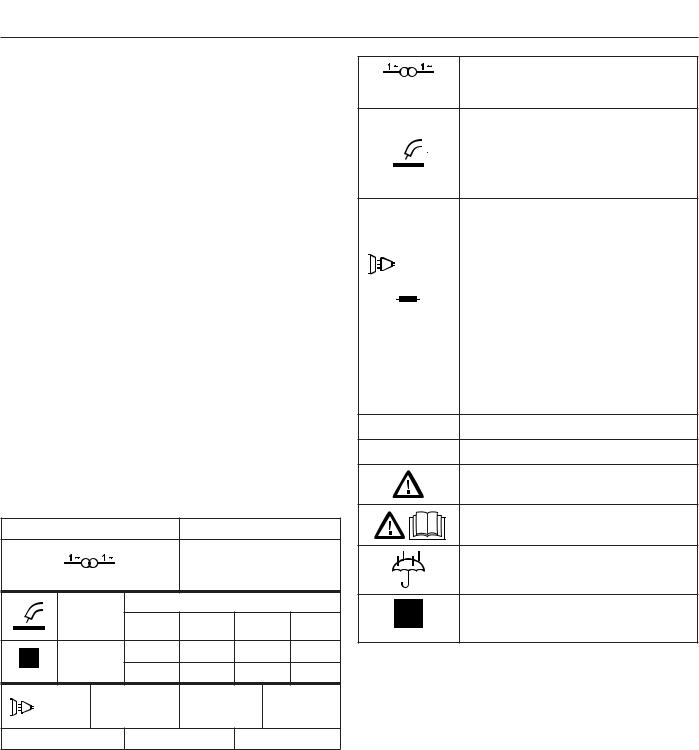
Technical details
Model:
Voltage U1:
Welding current I2: No-load voltage U0: Protection rating:
Insulation class:
Weight:
Welding wire:
Welding wire:
Welding current:
Material thickness 1.0–2.0 mm:
Material thickness 2.0–6.0 mm:
flux-cored wire welder PFDS 33 A1
230 V ~ / 50 Hz (alternating current)
48 A/90 A
27.5 V
IP 21S
H
12.7 kg
Ø 0.7/0.8/0.9/1.0 mm
approx. 450 g
with Ø 0.7 / 0.8 mm welding wire, welding current 48 A – 60 A
with Ø 0.8/0.9/1.0 mm welding wire, welding current 70 A – 90 A
Duty cycle X: 10% at 90 A welding current 60% at 48 A welding current
Rating plate and explanation of symbols
PFDS 33 A1 |
S/N: |
EN 60974-1:2012
EN 60974-10:2014/A1:2015
Class A
~ 50 Hz |
48 A / 16 V – 90 A / 18.5 V |
||||
X |
10 % |
60 % |
|||
|
|
||||
U0 = 27.5 V |
I2 |
90 A |
48 A |
||
U2 |
18.5 V |
16 V |
|||
|
|
||||
1~ 50 Hz |
U1 = 230 V |
I1max = 13 A |
I1e = 4.8 A |
||
IP21S |
|
|
|
12.7 kg |
|
|
|
|
|
|
|
|
|
|
|
|
|
|
|
|
|
|
|
|
|
|
|
|
|
|
|
|
|
|
Single-phase transformer |
|||
|
|
|
|
|
|
|
|
|||
|
|
|
U0 |
Nominal no-load voltage |
||||||
|
|
|
|
|
|
|
||||
|
Ø mm |
Permissible flux-core wire diameter |
||||||||
|
|
|
|
|
|
|
Symbol for self-shielded flux-core welder |
|||
|
|
|
|
|
|
|
||||
|
|
|
|
|
|
|
|
|||
|
|
|
|
|
|
|
|
|
|
|
|
|
|
|
I2 |
Rated value of the welding current |
|||||
|
|
|
|
|
|
|
|
|||
|
|
|
|
X |
Duty cycle in % |
|||||
|
|
|
U2 |
Standardised working voltage |
||||||
|
|
|
|
|
|
|
||||
|
|
|
|
|
|
|
|
|||
|
|
|
|
1~ 50 Hz |
Mwains supply, number of phases alternating |
|||||
|
|
|
|
|||||||
|
|
|
|
current symbol and rated value of the frequency |
||||||
|
|
|
|
|
|
|
|
|
|
|
|
|
|
|
16A |
Nominal value of the required mains fuse |
|||||
|
|
|
|
|
|
|
||||
|
|
|
|
|
|
|
|
|
|
|
|
|
|
U1 |
Rated value of the mains voltage |
||||||
|
|
|
|
|
|
|
||||
|
|
|
|
|
|
|
|
|||
|
I1 max. |
Max. rated value of the mains current |
||||||||
|
|
|
|
|
|
|
|
|
|
|
|
|
I1 e |
E ective value of the max. mains current (A) |
|||||||
|
|
|
|
|
|
|
||||
|
|
|
|
|
|
|
|
|||
|
IP21S |
Protection class |
||||||||
HInsulation class
12.7 kg Weight of the appliance
Follow the safety regulations
Read the operating instructions
Do not store or use the appliance in wet environment or in rain
Symbol for welding power sources that are suitable for welding in environments with increased electrical risks.
PFDS 33 A1 |
GB│IE│NI │ 3 ■ |
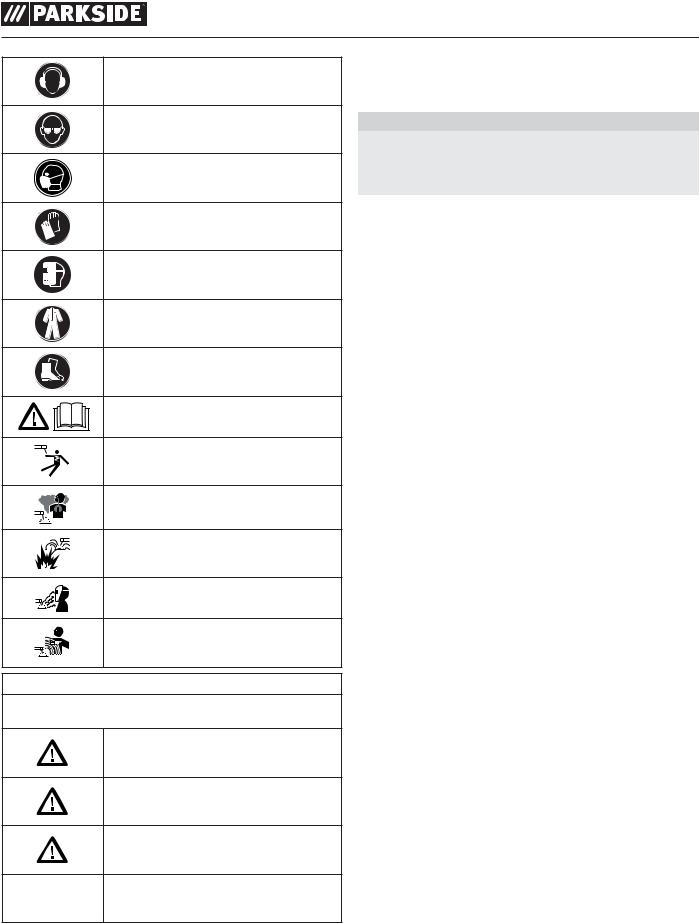
Wear ear protection!
Wear protective goggles!
Wear a dust mask!
Wear protective gloves!
Use the welding mask!
Wear protective clothing!
Wear protective shoes!
Caution! Read instruction manual!
Electric shock from welding electrode can kill!
Breathing welding fumes can be hazardous to your health!
Welding sparks can cause explosion or fire!
Arc rays can burn eyes and injure skin!
Electromagnetic field can cause pacemaker malfunction!
Explanation of symbols
The following symbols and signal words are used in these instructions, on the flux-core welder or on the packaging.
HAZARD!This signal word indicates a hazard with a high degree of risk that will result in death or serious injury if not prevented.
WARNING!This signal word indicates a hazard with a medium level of risk which could lead to death or serious injury if not prevented.
CAUTION!This signal word indicates a hazard with a low level of risk which could result in a minor or moderate injury if not prevented.
NOTE!This signal word warns of possible damage to property or gives useful additional information on assembly or operation.
Safety
Basic safety instructions
 WARNING! RISK OF ELECTROCUTION!
WARNING! RISK OF ELECTROCUTION!
►Dangers for children and persons with limited physical, sensory or mental capabilities (for example, partially handicapped people or older people with limitations to their physical or mental abilities) or lack of experience and knowledge (for example, older children).
■The flux-core welder may only be used by adults.
■Children should be supervised to ensure they do not play with the fluxcore welder.
■Keep children away from the packaging materials and small components. Swallowing can lead to a risk of su ocation.
■Ensure that the appliance is suitably maintained.
■Maintenance and/or repairs may only be performed by qualified persons.
■In addition to the notices in these operating instructions, all general safety and accident prevention legislation must also be complied with.
■Always pay attention to what you are doing and always be alert. Do not work with the flux-core welder if you are distracted or under the influence of drugs, alcohol or medication. Just one moment of inattention while operating this appliance may result in an accident and serious personal injuries.
■Check the appliance for any possible defects before use. If the appliance exhibits any faults, it must not be used under any circumstances.
■Ensure that the welding lead, nozzle, the torch and earth connections are all in perfect condition. Wear on the insulation and the live parts can cause dangerous situations and reduce the quality of the welding work.
■Use this appliance only as described in this instruction manual.
■Using this appliance can lead to wear on certain parts. Therefore, check the appliance regularly for any possible damage or defects.
■For your own safety, use only the additional equipment and accessories specified in the operating instructions or recommended by the manufacturer.
■When setting up the appliance, ensure that it is placed on a stable and safe working surface.
■On heavily used supply networks and power circuits, welding work can lead to problems for other users. If in doubt, consult your electricity provider.
■Comply with all national guidelines and laws when welding. This applies, in particular, to accident prevention regulations.
■The flux-core welder may only be used on a stable and level surface. The flux-core welder is constructed so that it can be tilted up to a maximum of 10° from the plane before tipping over. Secure the flux-core welder against tipping if working on an inclined plane.
■To avoid damage to the appliance, always transport the appliance in an upright position.
■ 4 │ GB│IE│NI |
PFDS 33 A1 |

Special safety instructions
 WARNING! RISK OF ELECTROCUTION!
WARNING! RISK OF ELECTROCUTION!
►Incorrect electrical installation, excessive mains voltage or incorrect handling can lead to an electric shock. Any electrical shock can be fatal.
■Do not connect the flux-core welder unless the mains voltage from the socket outlet corresponds to the requirement given on the type plate.
■Connect the flux-core welder only to an easily accessible socket, so that it can be quickly disconnected from the mains in the event of an accident.
■Do not operate the flux-core welder if it has any visible damage or the mains cable or plug are defective.
■The mains connection cable used is a high-quality line that must not be damaged. While working, ensure that it does not come into contact with any hot objects. If the connecting lead is damaged it must be replaced by a specific connecting lead that is available from the manufacturer or its customer service. The main connecting lead may only be replaced by the manufacturer or its customer service or a similarly qualified person.
■Do not open the housing except as described in these instructions. Have all repairs carried out by qualified specialists. Contact a specialist workshop. Unauthorised repairs, improper connection or incorrect operation will invalidate any liability or guarantee claims.
■Never insert any pointed and/or metallic objects into the interior of the appliance.
■Repairs may only be made using parts that correspond to the original appliance specifications. This flux-core welder contains electrical and mechanical parts that are vital as protection against sources of danger.
■Protect the flux-core welder from damp and use it only in dry, interior rooms.
■Never immerse the flux-core welder, the power cable or the plug in water or other liquids.
■Never touch the flux-core welder or the plug with wet hands.
■Avoid all direct contact with the welding current circuit. The no-load voltage between the flow nozzle and the earth clamp can be dangerous.
■Do not pull on the mains cable to remove the plug from the socket; always pull on the plug itself.
■Avoid any tensile load on the mains cable.
■Unplug the appliance before setting it up at a di erent location.
■Keep the flux-core welder, mains plug and power cable away from open flames and hot surfaces.
■Do not kink the mains cable.
■Protect all cables from oil, sharp edges and high temperatures.
■If you are not using the flux-core welder, cleaning or calibrating it or if there is a malfunction, switch o the flux-core welder and pull the plug out of the power socket.
 WARNING! RISK OF INJURY!
WARNING! RISK OF INJURY!
►Improper handling can lead to severe injuries!
■Position the power cable so that it does not present a tripping hazard.
■The light radiation emitted by the electric arc can cause damage to the eyes. Protect your eyes using suitable protective glasses (DIN EN 166, DIN EN 169/protection level 10) that you can attach to the supplied welding mask.
■The light radiation emitted by the electric arc can cause burns to the skin. Use gloves and dry protective clothing that is free of oil and grease to protect the skin from exposure to the ultraviolet radiation of the electric arc.
■The welded workpiece starts to glow and remains very hot for quite a long time. Make sure that it has cooled down before touching it.
■Arc welding can cause vapours to be released that may be hazardous
to health.
■Ensure that there is no one within a radius of 15 m of the electric arc who is not wearing protective clothing and eye protection. Protect yourself and any bystanders from the possible hazardous e ects of the electric arc!
 WARNING! RISK OF FIRE!
WARNING! RISK OF FIRE!
►Improper handling can lead to fires or explosions.
■Arc welding causes sparks, melted metal parts and smoke. Therefore ensure that you remove all flammable substances and/or materials from the working area.
■The welded workpiece starts to glow and remains very hot for quite a long time. It can thus come into contact with flammable materials and cause a fire.
■Do not weld receptacles, containers or pipes that have been used for flammable liquids or gases.
 WARNING! ELECTROMAGNETIC FIELDS!
WARNING! ELECTROMAGNETIC FIELDS!
►The flux-core welder and the electric arc can generate electrical or electromagnetic fields that can cause electronic systems and appliances to malfunction. These include IT systems, telecommunications systems, electronically controlled appliances and machines. Mains and signal lines can be interrupted. Pacemakers may also be a ected.
■Observe the maintenance instructions.
■Unwind the earth cable  and the cable assembly
and the cable assembly  completely. Coiled cables can enhance electromagnetic fields.
completely. Coiled cables can enhance electromagnetic fields.
■Provide su cient shielding for appliances or machines sensitive to radiation.
■If you wear a pacemaker, consult your doctor before welding.
 CAUTION!
CAUTION!
►Improper handling can lead to overheating of the flux-core welder and property damage.
■The flux-core welder may not be restricted or placed directly against the wall during its functional life to ensure that enough air can always be taken up through the ventilation slit.
■Make sure that there is always adequate ventilation.
Complementary safety instructions
■Risk of electric shock: Electric shock from welding electrode can kill. Do not weld in the rain or snow. Wear dry insulating gloves. Do not touch electrode with bare hands. Do not wear wet or damaged gloves. Protect yourself from electric shock by insulating yourself from workpiece. Do not open the equipment enclosure.
■Risk induced by welding fumes: Breathing welding fumes can be hazardous to your health. Keep your head out of the fumes. Use equipment in an open area. Use ventilating fan to remove fumes.
■Risk induced by welding sparks: Welding sparks can cause explosion or fire. Keep flammables away from welding. Do not weld near flammables. Welding sparks can cause fires. Have a fire extinguisher
nearby and have a watchperson ready to use it. Do not weld on drums or any closed containers.
■Risk induced by the arc: Arc rays can burn eyes and injure skin. Wear hat and safety glasses. Use ear protection and button shirt collar. Use welding helmet with correct shade of filter. Wear complete body protection.
■Risk induced by electromagnetic fields: Welding current produces electromagnetic field. Do not use with medical implants. Never coil welding cables around your body. Route the welding cables together. The safety instructions for engine driven power sources shall also include:
PFDS 33 A1 |
GB│IE│NI │ 5 ■ |

Potential hazards
There are a number of potential hazards that can occur during arc welding. It is therefore particularly important for the welder to comply with the following rules to avoid endangering himself or others and prevent injuries or damage to the appliance.
Do not use this flux-core welder on a surface that is inclined by more than 10°.
Work on the voltage side, e.g. on cables, plugs, sockets, etc., may only be carried out by qualified specialists. This applies especially to the fitting of intermediary cables.
In the event of an accident, disconnect immediately from the welding power source.
If electrical contact voltages occur, switch o the appliance immediately and have it checked by a qualified specialist.
Always ensure good electrical contacts on the welding current side.
Always wear insulating gloves on both hands during welding work. These protect the user from electric shock (no-load voltage of the welding current circuit), harmful radiation (heat and UV radiation) as well as from incandescent metal and splashes of slag.
Wear sturdy insulating shoes (should also be waterproof). Loafers are not suitable as falling incandescent metal droplets can cause burns.
Wear suitable clothing, no synthetic fibres.
Do not look into the electric arc without eye protection; always use the welding mask with the prescribed protective glass as per DIN. In addition to the light and heat radiation, which can dazzle and/or cause burns, the electric arc also emits UV radiation. If not properly protected, this invisible ultraviolet radiation can cause a very painful conjunctivitis that is not apparent until several hours later. In addition, this UV radiation can cause sunburn-like e ects on unprotected parts of the body.
Any persons in the vicinity of the electric arc or helpers must be appraised of the dangers and be equipped with the necessary protective equipment. If necessary, put up protective walls.
No welding work may be carried out on containers that have been used for storing gases, fuels, mineral oils or similar – even if they have been empty for a long time – as possible residues may present a risk of explosion.
Special regulations apply in rooms where there is a risk of fire or explosion.
Welded joints that are subject to heavy stress loads and are required to comply with safety requirements may only be carried out by trained and qualified welders. Examples of this are: pressure vessels, running rails, tow bars, etc.
Risk of injury due to electric shock
When there is no electric arc, there is a nominal no-load voltage of U0 between the earth clamp and the flow nozzle. This voltage can be potentially fatal if the welder touches the flow nozzle, torch nozzle, welding wire or the workpiece with his/her bare hands.
It is important to bear in mind that the protective conductor in electrical systems or appliances can be damaged by negligence by the welding current:
e.g. the earth clamp is placed on the welder housing which is connected to the protective conductor of the electrical system. The welding work is carried out on a machine with a protective conductor connection. It is also possible to weld the machine without attaching the earth clamp to it. In this case, the welding current flows from the earth clamp via the protective conductor to the machine. The high welding current can cause the protective conductor to melt.
The supply to the mains socket must be secured as per regulations (VDE 0100). In accordance with these regulations, only fuses or circuit breakers with a corresponding wire cross section may be used (16 amp circuit breaker). A too high fuse amperage can cause cable fires or building fire damage.
Confined spaces and hot rooms
When working in confined spaces or hot rooms, use insulated underlays, filler layers and gauntlets made of leather or a di erent non-conduc- tive material to insulate your body against the floor, walls, conductive appliance parts and similar.
When using welding transformers to weld in environments with increased electrical risks, e.g. in confined rooms with electrically conductive walls (boilers, pipes, etc.), in hot rooms (sweating through the work clothes), the output voltage of the flux-core welder in no-load operation may not be higher than 48 V~ (e ective value). Due to its output voltage in no-load operation, the appliance may be used in this case.
Accident risks due to poor air supply in confined spaces
Considerable quantities of smoke and gases are produced during welding. Ensure that there is a suitable opening for the extraction of smoke and gases. Never feed oxygen into the room. This increases the risk of fire.
Protective clothing
While working, the welder must protect all body parts from radiation and against burns by means of clothing and the welding mask.
Wear gauntlets made of a suitable material (leather) on both hands. They must be in perfect condition.
To protect your clothes from flying sparks and burns, wear a suitable apron. If the type of work requires it, e.g. overhead welding, wear a protective suit and, if necessary, also the corresponding headgear.
The clothing worn and all accessories must comply with the guideline “Personal protective equipment” (89/686/EEC).
■ 6 │ GB│IE│NI |
PFDS 33 A1 |

Protection against radiation and burns
Warn of the danger to the eyes by hanging up a sign saying “Caution, do not look into the flames!”.
Work areas are to be shielded so as to protect people in the vicinity.
Keep unauthorised persons away from the welding work.
Do not set up fixed welding locations in the immediate vicinity of light-coloured or glossy walls.
Windows should be blocked o to at least head height to prevent the escape or reflection of radiation, e.g. by painting with a suitable paint.
Risk of burns due to flying sparks
The spraying welding sparks can cause painful burns. Therefore, observe the following guidelines:
Always wear a leather apron.
Use leather gloves.
For overhead welding, wear suitable headgear.
Ensure that your trouser cu s fall over your shoes.
Wear sturdy and insulated shoes.
Risk of accidents due to spattering slag
When it sets, the slag is hard and brittle. Afterwards, it can be chipped o using the chipping hammer – sharp-edged particles may fly up that could seriously injure your eyes.
Therefore protect your eyes by wearing suitable protective goggles when removing slag.
Risk of fire due to flying sparks
If molten or incandescent metal and slag particles fall onto flammable substances, these can ignite and cause a fire. Therefore, remove all flammable objects from the working area before commencing welding work. Keep a suitable fire extinguisher at hand.
Pay particularly close attention to the following materials.
Paper
Rags
Textiles
Wood and wood fibres
Rubber
Plastic
Petrol
Oils
Tar-like substances
Paints and solvent
Risk of explosion
Both the welding function and the superheated weld joint itself can cause explosions. Therefore, do not use the appliance in a potentially explosive environment containing combustible liquids, gases or paint mist.
Please also note:
When the flux-core welder is in operation, do not lay the torch on the flux-core welder itself or any other electrical appliance.
Before finishing the welding work, do not touch the flow nozzle or any other metal object with which the flow nozzle is in contact.
Disconnect the appliance from the power immediately after completing your welding work.
Ensure that no cable is wrapped around any body part.
Make sure that you are not within the welding current circuit. The welding torch and earth must always be on the same side.
EMC appliance classification
As per the standard IEC 60974-10, this appliance is a welding unit with class A electromagnetic compatibility. Thus it complies with the corresponding requirements for industrial and domestic use. In residential areas, it may be connected to the low voltage electricity supply.
Even the flux-core welder complies with the emission limits of the standard, arc welding appliances can nevertheless cause interference to sensitive systems and appliances.
The user is responsible for any interference caused by the electric arc during welding and must take appropriate preventive measures. The user must pay close attention to the following:
Power, control, signal and telecommunication lines
Computers and microprocessor-controlled appliances
TVs, radios and other playback appliances
Electronic and electrical safety appliances
People with pacemakers or hearing aids
Measurement and calibration systems
The electromagnetic immunity of other systems in the vicinity
The time of the day at which the welding work is to be carried out. To prevent possible interference radiation, we recommend:
Fitting a mains filter to the mains connection or shielding it with a metal pipe
Maintaining the flux-core welder regularly and keeping it in good condition
Weld cables should be as short as possible, completely unwound and running as close to parallel with the floor as possible
An equipotential bonding should be provided
The workpieces should be properly earthed
Any appliances susceptible to interference radiation should moved out of the welding area, if possible, or shielded.
PFDS 33 A1 |
GB│IE│NI │ 7 ■ |
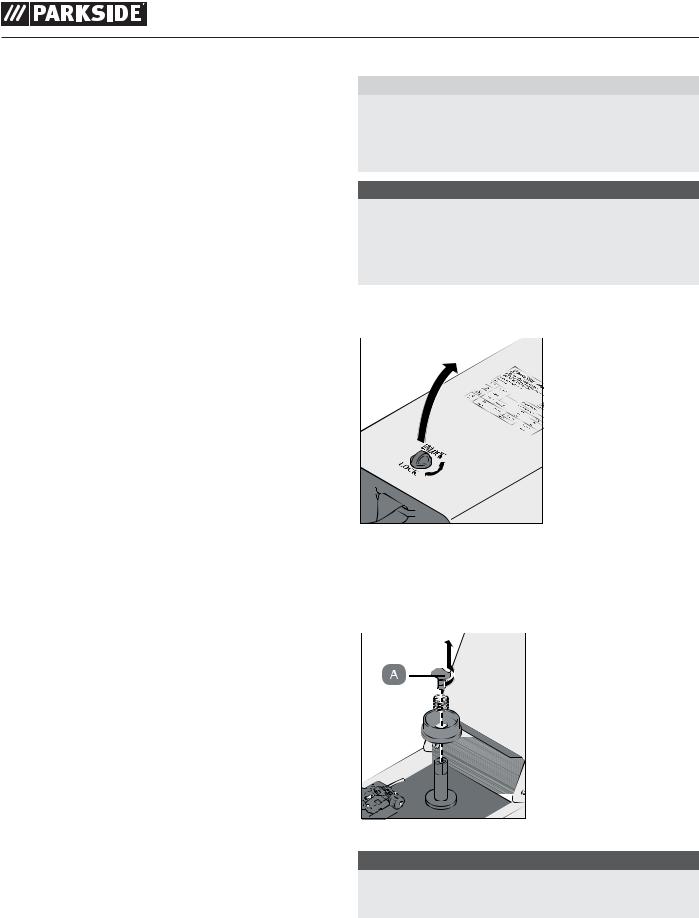
Unpacking and checking the package contents
1.) Remove all components from the packaging and check whether the flux-core welder or the individual components show any signs of damage. If this is the case, do not use the flux-core welder. Contact the manufacturer via the service address provided on the warranty card.
2.) Remove all protective films and other transport packaging.
3.) Check that the delivery is complete.
Assembly
Fitting the welding mask
♦Fold the side parts of the mask inwards.
Press the integrated clips into the corresponding holes so that they click into each other (see fig. D).
♦Lay the dark welding lens  into the mask
into the mask  with the writing at the top (see fig. E).
with the writing at the top (see fig. E).
The writing on the dark welding lens  must now be visible from the front side of the welding mask.
must now be visible from the front side of the welding mask.
♦Push the handle  from the inside into the corresponding recess on mask, until it clicks into place (see fig. F).
from the inside into the corresponding recess on mask, until it clicks into place (see fig. F).
Filling with flux-cored wire
 WARNING!
WARNING!
►To avoid the danger of electric shock, injury or damage:
–Before maintenance or pre-work preparation activity, always disconnect the mains plug from the mains power socket.
NOTE
►Depending on the application, di erent types of flux-core wires will be required. This appliance can use wires with a diameter from 0.7–1.0 mm.
►The feed roller, torch nozzle and wire diameter must always match.
►The appliance is designed for wire rolls of up to a maximum of 450 kg.
♦Open the cover of the wire feed unit  by turning the catch
by turning the catch  (see arrow marking) to the position UNLOCK (see fig. 1).
(see arrow marking) to the position UNLOCK (see fig. 1).
Fig. 1
♦Unlock the roller unit by turning the roller mount A 90° anticlockwise (see fig. 2).
♦Pull the roller unit from the shaft (see fig. 2).
Fig. 2
NOTE
►Make sure that the end of the wire does not come loose and cause the roll to roll out on its own. The end of the wire may not be released until during assembly.
■ 8 │ GB│IE│NI |
PFDS 33 A1 |
